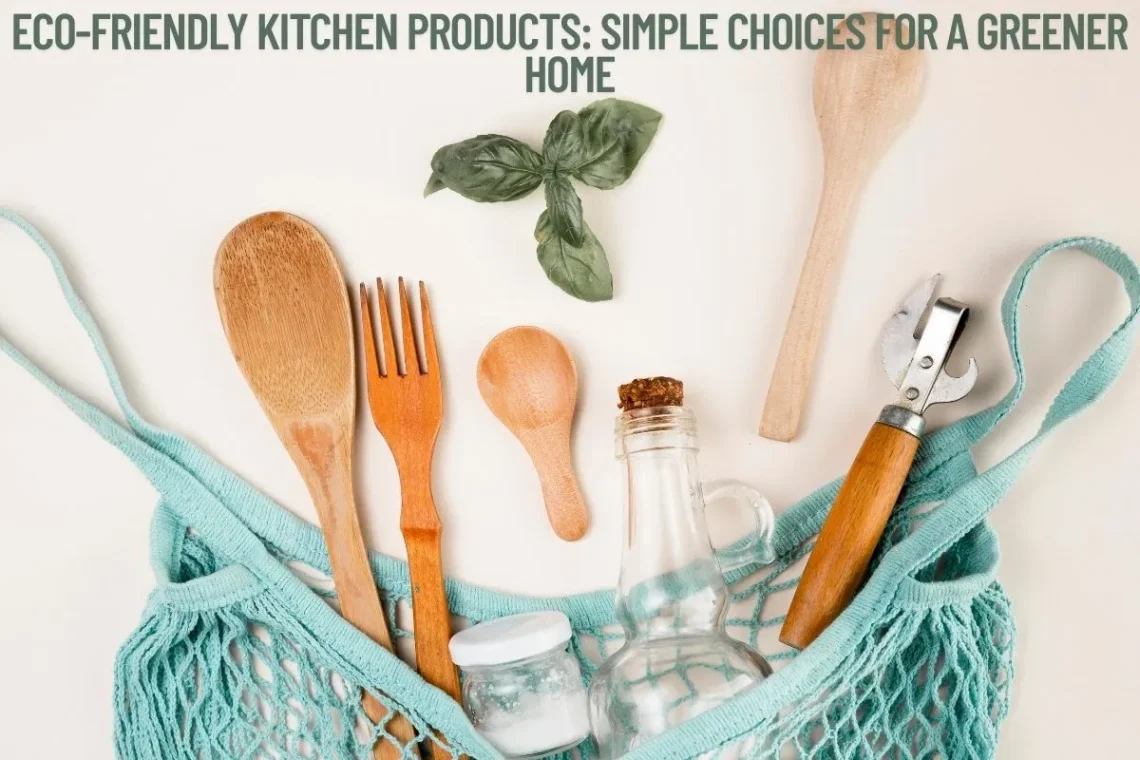
Eco-Friendly Kitchen Products: Simple Choices for a Greener Home
When I think about my kitchen today, it looks very different from the one I grew up in. Back then, we had lots of plastic containers, non-stick pans that scratched easily, and disposable items we didn’t think twice about. Over the years, I started noticing how much waste I created just by cooking daily meals. That’s when I decided to slowly switch to eco-friendly kitchen products. The change didn’t happen overnight, but every little step made a big difference.
In this guide, I’ll share practical ways to make your kitchen greener, safer, and more sustainable. I’ll include things I’ve tried myself, products that actually last, and even some easy DIY solutions you can make at home.
Table of Contents
ToggleWhy Eco-Friendly Kitchens Matter
The kitchen is the heart of most homes. But it’s also where we use the most disposable plastics, harsh cleaning chemicals, and energy-hungry appliances. Choosing eco-friendly kitchen products can:
-
Reduce waste in landfills.
-
Keep harmful chemicals out of food.
-
Save money in the long run.
-
Make the home healthier for everyone.
When I switched from plastic wrap to beeswax wraps, I noticed how little plastic waste I had by the end of the week. Small changes really add up.
What Are the Eco-Friendly Kitchen Options?
Eco-friendly kitchen options are simply products or habits that reduce harm to the environment. Some options are as simple as replacing a single-use product with a reusable one. Others involve investing in durable, high-quality items that last for years.
Here are some categories of eco-friendly kitchen choices:
-
Reusable food storage – Glass jars, stainless steel containers, and beeswax wraps.
-
Sustainable cookware – Cast iron pans, stainless steel pots, and ceramic-coated cookware.
-
Eco utensils – Wooden, bamboo, or steel spoons, ladles, and spatulas.
-
Energy-efficient appliances – Induction stoves, pressure cookers, and smart refrigerators.
-
Zero-waste cleaning supplies – Compostable sponges, reusable cloth towels, and natural cleaners.
-
Sustainable dining items – Cloth napkins, reusable straws, and stainless steel cutlery.
I remember the first time I used a stainless-steel lunch box instead of plastic. It felt heavier but stronger. After months of use, it still looked brand new. That moment convinced me to buy fewer but better products.
Which Products Are Eco-Friendly?
Not every product labeled “eco-friendly” is truly sustainable. Some companies use green packaging but still sell disposable or harmful products. To keep it simple, here are truly eco-friendly items worth considering:
1. Food Storage Alternatives
-
Beeswax wraps instead of plastic wrap.
-
Glass jars instead of disposable plastic boxes.
-
Stainless steel containers for durability and safety.
Personal Note: I store homemade pickles in old glass jars. It feels nice to reuse them instead of throwing them away.
2. Cookware That Lasts
-
Cast iron pans – they get better with age if you season them well.
-
Stainless steel pots – safe, long-lasting, and easy to recycle.
-
Ceramic-coated pans – free from harmful chemicals like Teflon.
3. Eco-Friendly Utensils
-
Bamboo spoons and spatulas.
-
Wooden chopping boards.
-
Stainless steel straws instead of plastic ones.
4. Energy-Saving Appliances
-
Pressure cookers save up to 70% energy compared to regular cooking.
-
Induction cooktops are more efficient than gas stoves.
-
LED lighting in the kitchen reduces electricity use.
5. Cleaning Tools
-
Compostable scrubbers made from coconut coir.
-
Reusable microfiber cloths instead of paper towels.
-
Homemade natural cleaners like vinegar and baking soda.
When I replaced my paper towels with washable cloth wipes, I cut down my waste bin by half. At first, it felt strange, but soon it became normal.
What Are Eco-Friendly Safe Kitchen Utensils?
Safe kitchen utensils should not only be eco-friendly but also free from harmful toxins.
Here are the safest choices:
-
Wooden Utensils
-
Gentle on cookware.
-
Compostable at the end of their life.
-
Last long if you oil them occasionally.
-
-
Bamboo Utensils
-
Lighter than wood.
-
Naturally antibacterial.
-
Grows fast, so it’s sustainable.
-
-
Stainless Steel Utensils
-
Extremely durable.
-
Easy to clean and sanitize.
-
Doesn’t leach chemicals into food.
-
-
Silicone Utensils (food grade)
-
Heat resistant and flexible.
-
Safer than plastic for cooking.
-
Reusable and easy to clean.
-
When my old plastic spatula melted slightly on a hot pan, I knew it was time to upgrade. I switched to a bamboo one, and it hasn’t let me down yet.
How to Make Eco-Friendly Products at Home?
Some of the best eco-friendly kitchen products don’t need to be bought. You can make them at home with simple ingredients.
1. DIY Natural Cleaner
Mix equal parts of water and white vinegar in a spray bottle. Add lemon peel for a fresh scent. This works as an all-purpose cleaner for countertops.
2. Reusable Cleaning Cloths
Cut old cotton t-shirts into squares. They work perfectly as cleaning rags and reduce the need for paper towels.
3. Homemade Scrubbers
Dry orange peels, grind them, and mix with baking soda. It works as a natural scrub for greasy pots.
4. Beeswax Wraps
Melt beeswax and spread it over cotton fabric. Once it cools, you get a reusable wrap for food.
I made my first batch of beeswax wraps using leftover cotton cloth from an old bedsheet. They didn’t look fancy, but they worked well. The satisfaction of making something useful at home is priceless.
Everyday Tips to Keep Your Kitchen Green
-
Buy in bulk to reduce packaging waste.
-
Carry your own cloth bag when grocery shopping.
-
Compost food scraps instead of throwing them in the bin.
-
Avoid single-use plastics whenever possible.
-
Choose products that last longer, even if they cost a little more.
One habit that changed my kitchen forever was composting. I used to throw peels and scraps into the trash, but now they go into a small compost bin. Later, I use that compost in my garden. It’s a cycle that feels right.
More Eco-Friendly Kitchen Swaps You Can Try
Sometimes the easiest swaps are the ones we overlook. Let me share a few more ideas that worked for me and friends who also tried moving toward greener kitchens.
1. Switch Plastic Wrap with Bowl Covers
If you don’t want to invest in beeswax wraps right away, cloth bowl covers are another option. I got a set made from cotton with elastic edges, and they fit snugly over bowls. The best part? I can wash them and reuse them endlessly.
2. Say Goodbye to Disposable Coffee Pods
Coffee machines with pods are convenient, but they create mountains of waste. Switching to a French press or pour-over coffee maker means zero waste (and honestly, better-tasting coffee). A friend of mine invested in a stainless-steel reusable coffee pod for her machine. It was a one-time purchase that saved her money and guilt.
3. Use Compostable Garbage Bags
Most kitchens still rely on plastic bin liners. But compostable bags made from cornstarch are a solid alternative. They break down naturally, unlike plastic.
4. Reusable Baking Sheets Instead of Parchment Paper
I bake a lot, and I used to go through rolls of parchment paper. Now, I use a silicone baking mat. It’s easy to wash, non-stick, and reusable for years.
Long-Term Benefits of Eco-Friendly Kitchens
Eco-friendly choices may feel like small wins, but the long-term benefits are huge.
-
Healthier Living
Cooking in stainless steel or cast iron means no harmful chemicals leaching into your food. I personally noticed how much better my meals taste when cooked in cast iron. -
Lower Costs
Reusable products save money in the long run. For example:
-
A single beeswax wrap lasts up to a year.
-
A cloth towel replaces hundreds of paper towels.
-
A cast iron skillet can last generations.
At first, I hesitated to spend extra on eco products, but the savings showed up months later.
-
Less Waste
You’ll notice your trash bin gets lighter. I used to empty mine daily. Now, sometimes it takes two to three days to fill up. -
Peace of Mind
There’s a certain calm in knowing you’re reducing harm. Cooking feels more intentional and mindful when you’re not constantly throwing things away.
Real-Life Scenarios: How Eco-Friendly Kitchens Work
Let’s walk through an example of how a day in an eco-friendly kitchen looks compared to a regular one.
Morning Routine
-
Old way: Plastic cereal bags, disposable coffee pods, and paper napkins.
-
New way: Oats in a glass jar, French press coffee, cloth napkin.
Cooking Lunch
-
Old way: Plastic chopping board, plastic spatula, aluminum foil for wrapping leftovers.
-
New way: Wooden chopping board, bamboo spatula, beeswax wraps.
Evening Cleaning
-
Old way: Harsh chemical sprays, paper towels, plastic scrubbers.
-
New way: Vinegar-lemon cleaner, reusable microfiber cloths, compostable scrubber.
When I switched to this style, my daily waste shrank so quickly that I had to buy fewer garbage bags. That itself was a sign of progress.
Community and Sharing Ideas
Going eco-friendly doesn’t have to be a solo journey. In fact, it’s more fun when you share ideas with others.
-
I once exchanged extra glass jars with a neighbor who had spare cloth napkins. It felt like a little eco-swap shop.
-
In my family WhatsApp group, we often share DIY cleaner recipes. My cousin swears by orange peel vinegar cleaner, and now I use it too.
-
Even local farmer’s markets sometimes promote eco-friendly packaging. Shopping there not only reduces waste but also supports local growers.
Community matters because the more people adopt these practices, the easier it becomes for everyone.
Overcoming Common Challenges
You might face a few bumps when trying to switch. Here’s how I tackled them:
-
Problem: Beeswax wraps felt stiff.
-
Solution: Warm them with your hands; they soften quickly.
-
-
Problem: Cloth towels stained too easily.
-
Solution: Keep light and dark towels separate, just like clothes.
-
-
Problem: Cast iron pan rusted.
-
Solution: I learned to dry it completely and rub a thin layer of oil after each wash.
-
-
Problem: Friends teased me about “overthinking waste.”
-
Solution: I simply showed them how much money I saved. Now, two of them are trying it too!
-
Challenges are normal, but with small adjustments, eco-living becomes second nature.
The Bigger Picture: Why Kitchens Matter Most
The kitchen is where most households create the largest daily waste. By starting here, we tackle the most impactful part of our lifestyle.
Think about it:
-
Cooking happens daily.
-
Packaging waste piles up daily.
-
Cleaning happens daily.
So, any eco-friendly change here has the most consistent long-term effect. Even switching one thing in the kitchen can reduce hundreds of plastic items over a year.
Unique Insights That Make a Difference
-
Durability is the real eco-friendliness. A product that lasts 10 years is always greener than one replaced every few months.
-
Local products are underrated. Buying clay pots from local artisans reduces transport emissions and supports small businesses.
-
Simplicity wins. Sometimes the most eco-friendly product is the one you already have. Using old glass jars or tiffin boxes is better than buying new “green” products.
-
Mindful cooking saves energy. Cooking with lids on, soaking beans before boiling, and using pressure cookers cuts energy use.
Final Thoughts
Switching to eco-friendly kitchen products is not just about saving the planet. It’s also about creating a healthier, more mindful lifestyle. Your food tastes better when cooked in safe cookware. Your kitchen feels lighter when it’s free from unnecessary plastic. And your waste bin shrinks week after week.
The best part is—you don’t have to do it all at once. Start with one change today. Maybe replace your plastic wrap with beeswax wraps. Or switch from paper towels to washable cloths. Over time, these small changes become habits.
One day, you’ll look around your kitchen and realize it’s not just eco-friendly—it’s a place where you feel good about every choice you make.
You May Also Like

Transform Your Windows to Prevent Energy Loss and Improve Comfort
August 26, 2025
Best Home Air Purifiers: UK Picks
August 19, 2025

